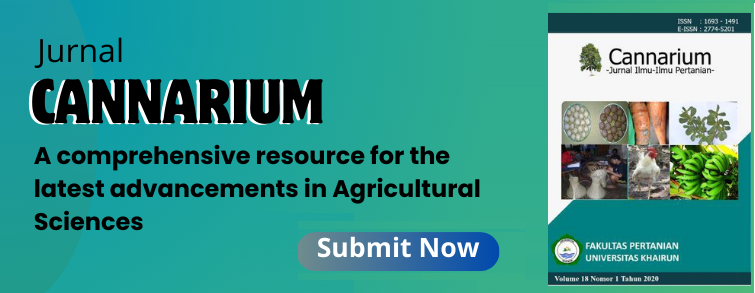Distribution and Number of Capilong (Calophyllum inophyllum) in Ternate Island of Indonesia
Sari
Indonesia has a diverse of new and renewable energy sources including biofuels. Biofuels are promising eco-friendly energy sources generated from biological raw materials. Biofuels can also be derived from the seeds of Capilong trees. However, the occurrence of Capilong trees in North Maluku has not been tapped to support a local economic income due to the lack of knowledge of the local community. The present study was undertaken with the aim at investigating the distribution and number of Capilong trees across Ternate Island. A field investigation using a census method was held to collect data on the number and distribution of Capilong trees while observing the following parameters: stage of growth, topography, rock materials and landforms. The findings revealed that Capilong trees are mostly occurred in a tree group, while the seedling population number was low. Interestingly, Capilong trees have demonstrated a natural characteristic that are tolerance to various topography, rock materials and landforms condition. It is therefore recommended to cultivate the plant through a community development program and classify the plant as a potential species that can be used for land rehabilitation programs.
Teks Lengkap:
PDFReferensi
Ashwath, N. 2010.Evaluating Biodiesel Potential of Australian Native and Naturalised Plant Species. Scientific Report. Rural Industries Research and Development Corporation. Australian Government. Australia.
Bentley, R.W. 2002. Global oil & gas depletion: an overview. Energy Pol. 30(3): 189-205. https://doi.org/10.1016/S0301-4215(01)00144-6.
Bhuiya, M. M. K., Mohammad, G.R., Khan, M.M.K., Nanjappa, A., Azad, A.K. and Mofijur, M. 2015. Optimisation of Oil Extraction Process from Australian Native Beauty Leaf Seed (Calophyllum inophyllum). Energy Procedia. 75:56-61.
Bhuiya, M. M. K., Mohammad, G.R., Khan, M.M.K., Nanjappa, A., Azad, A.K., Hazrat, M.A. 2016. Prospects of 2nd generation biodiesel as a sustainable fuel – Part 2: Properties, performance and emission characteristics. Renew & Sust. Energy Rev. 55:1129-1146. https://doi.org/10.1016/j.rser.2015.09.086.
Dweck, A.C. and Meadows, T. 2002. Tamanu (Calophyllum inophyllum) – the African, Asian, Polynesian and Pacifific Panacea. Int J Cosmet Sci. 24:1-8.
Edmonds, W.J., Thomas, P.J., Simpson, T.W. and Baker, J.C. 1998. Land Judging and Soil Evaluation. Available online. https://www.researchgate.net/publication/237327201.
Erdiwansyah, E., Mahidin, M. and Husni, H. 2021. Investigation of availability, demand, targets, and development of renewable energy in 2017–2050: a case study in Indonesia. Int J Coal Sci Technol.Open access. https://doi.org/10.1007/s40789-020-00391-4.
Friday, J.B. and Okano, D. 2006. Calophyllum inophyllum (Kamani). Paper. Available online. Retrieved on 1st August 2021.
Jahirul, M.I., Mohammad, G.R., Ashfaque, A.C. and Nanjappa, A. 2012. Biofuels production through biomass pyrolysis - a technological review. Energies. 5:4952-5001. doi:10.3390/en5124952.
Leksono, B., Sukartiningsih, Windiyarini, E., Hamdan, A., Adinugraha, Yustina, A., Jino, K., and Himlal, B. 2021. Growth performance of Calophyllum inophyllum at a bioenergy trial pot in Bukit Soeharto Research and Education Forest. IOP Conference Series: Earth Environ Sci, 749: 1-14. doi:10.1088/1755-1315/749/1/012059.
Leksono, B., Windiyarini, E. dan Hasnah, T.M. 2014. Budidaya Tanaman Nyamplung (Calophyllum inophyllum) untuk Bioenergi dan Prospek Pemanfaatan Lainnya. 51 Hal. Kementerian Kehutanan. Jakarta.
Ministry of Energy and Mineral Resources of the Republic of Indonesia. 2017. Handbook of Energy & Economic Statistics of Indonesia. 129 Hal. Jakarta.
Syakir, M. dan Karmawati, E. 2009. Nyamplung (Calophyllum inophyllum L.). Badan Penelitian dan Pengembangan Perkebunan. Jakarta. Available online. Retrieved on 1st August 2021.
Wise, M., James, D., Patrick, L., Catherine, C. and Page, K. 2014. Agriculture, land use, energy and carbon emission impacts of global biofuel mandates to mid-century. App. Energy. 114:763-773. https://doi.org/10.1016/j.apenergy.2013.08.042.
DOI: https://doi.org/10.33387/cannarium.v19i1.3409
Refbacks
- Saat ini tidak ada refbacks.
##submission.copyrightStatement##
| Journal Policies | Submissions | People | Â Information |
Editorial Officer Cannarium
Faculty of Agriculture, Universitas Khairun
Jl. Jusuf Abdurahman, Gambesi, Ternate, North Maluku - Indonesia
E-mail : cannarium@unkhair.ac.id or cannarium.unhkair@gmail.com
Cannarium Publisher Faculty of Agriculture, Universitas Khairun This work is licensed under a Creative Commons Attribution-NonCommercial-ShareAlike 4.0 International License.



